Beauty: who cares, wins!
An Office for Place event in conjunction with RIBA discussing how government and architects can collaborate to make healthy, sustainable communities, fit for the future.

Exterior view of RIBA building, a grand neoclassical structure with columns and a large pediment.
Reflections on the event from Paul Monaghan, Executive Director at AHMM architects and member of the Office for Place Advisory Board.
The Office for Place in conjunction with the Department for Levelling Up, Housing and Communities (DLUHC) held a rich and lively discussion with over 350 built environment experts, architects, designers and industry leading professionals at the Royal Institute of British Architects. This timely event titled Beauty: Who Cares, Wins!, presented an opportunity to discuss the role of design in planning policy and the use of design codes in the planning system.
There is a clear ambition of this government to encourage the production and use of design codes as a tool for supporting the creation of beautiful places, with engagement from communities at the outset, and the attendance of Lucy Frazer, the former Housing Minister at DLUHC, represents a willingness by government to engage with the wider industry directly on these important topics.
A discussion of this nature at RIBA with opening remarks by the President of RIBA, Simon Allford, highlights the architectural professions ambitions to remain in close conversation with government on important policy and guidance that concerns the built environment and the need for architectural expertise and knowledge to guide and support the production of design codes.
Nicholas Boys Smith, Chair of the Advisory Board of the Office for Place and Joanna Averley, Chief Planner, both emphasised the underlying theme and message of this event: to improve and nurture our built environment, working closely with local communities, and reminding the audience that the journey to create well-designed places has been a long one and there is still much to do.
David Rudlin, Director of Urban Design at BDP, masterfully presenting what a design code is and how they can be used, with Bob Allies, founder of Allies and Morrison, and Martina Juvara, director of Urban Silence giving insights to their experiences of using design codes and engaging communities meaningfully in the design of new neighbourhoods.
A series of 4 short presentations showed very different approaches to bring community voices to the fore, through co-design and co-production projects such as We Made That’s work to embed community knowledge in projects at Walworth Road, and POoR Collective’s work engaging year 10 pupils to design an architectural intervention together, to Ash Sakula’s post occupancy documenting of residents views about what living in The Mallings has meant to them, finishing with a presentation showing how digital engagement using apps such as Commonplace can allow council’s to reach a wide cross-section of communities.
Beauty continues to be an area of great interest and sparks differing views as to its place in policy. This was epitomised by the final debate of the session that gave the opportunity for the audience to share their views and question a diverse panel: Stephen Bayley, Presenter and Chair of the Royal Fine Art Commission Trust; Selina Mason, Director of Masterplanning at Lendlease; Robert Adam, architect and Office for Place Advisory Board member and Chanuki Seresinhem, Head of Data Science at Zoopla.
The debate began with views from each panellist – Bayley speculated on whether it was appropriate to pin down beauty and emphasised its particularity to human nature drawing widely from cultural references, whereas Seresinhem, offered a valuable insight into how artificial intelligence can be utilised to collect and measure beauty, with Mason commenting on how places evolve, change and can decline over time and how beauty can deteriorate if places are not looked after and maintained. The questioning from the audience offered an opportunity to debate the potential limitations of various engagement techniques and the need to create and offer a balanced approach.
Robert Adam and I sit on the Advisory Board of the Office for Place and with our architectural knowledge hope to continue providing architectural support and play a role in improving design quality. Beauty is an important factor in the development of an innovative and sustainable built environment and this event and the active debate with an audience of architects and designers, demonstrates how vital it is for government to continue to work with the wider industry.
We’re seeking to hold a similar event in the north so anticipate more information soon.